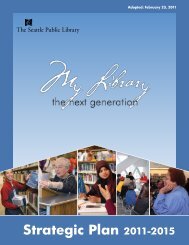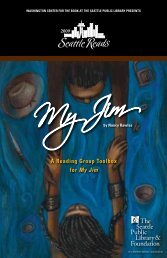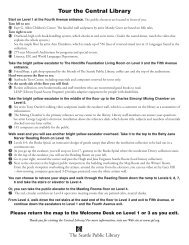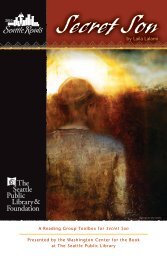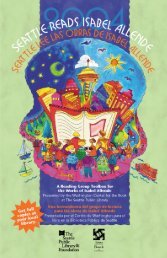Download - Seattle Public Library
Download - Seattle Public Library
Download - Seattle Public Library
Create successful ePaper yourself
Turn your PDF publications into a flip-book with our unique Google optimized e-Paper software.
The Namesake<br />
1. The Namesake explores things we inherit from our parents, including our names:<br />
their meaning, why we have them, who gave them to us. What are the similarities<br />
and differences in naming practices in Bengali and American cultures? Other<br />
cultures?<br />
2. How do Gogol’s “good” public name and private pet name color the way he<br />
views his world, how he defines himself, and how he shapes his life? Why is it<br />
important for him to accept his name?<br />
3. In what ways are Ganguli family members forced to separate themselves from<br />
their homeland? How does Gogol, over the years, try to separate himself from his<br />
parents and their heritage?<br />
Interpreter of Maladies<br />
1. In “A Temporary Matter,” a married couple drifts apart in the aftermath of their<br />
child’s death. During the blackout in their neighborhood, how do the stories and<br />
truths that they share draw them together and further apart?<br />
2. “This Blessed House” tells the story of Sanjeev and Twinkle, a newly married<br />
Indian American couple, who discover a treasure-trove of Christian iconography<br />
in their new home. What do these discoveries and how they react to them say<br />
about the couple and their marriage?<br />
3. In “Mrs. Sen’s,” we see the immigrant experience through a young American boy’s<br />
eyes. Why does the author choose this boy as the narrator? What do Mrs. Sen’s<br />
struggles with assimilation show us about life in a new country?<br />
4. Ashima compares being a foreigner to a perpetual pregnancy where one feels<br />
out of sorts and elicits curiosity from strangers: “It is an ongoing responsibility, a<br />
parenthesis in what had once been ordinary life, only to discover that the previous<br />
life has vanished, replaced by something more complicated and demanding.”<br />
(Page 49.) What do you think of Ashima’s view of being a foreigner?<br />
5. On page 78, Gogol’s father quotes Dostoyevsky by saying “We all came out of<br />
Gogol’s overcoat.” What did Dostoyevsky mean, and why does Ashoke quote him?<br />
6. How does the inscription in Gogol’s book from his father, “The man who gave<br />
you his name from the man who gave you your name,” reflect one of the book’s<br />
main themes?<br />
7. In what ways does the train wreck Ashoke Ganguli experiences in early adulthood<br />
influence his life? How does this situation work as a metaphor in the story?<br />
8. There are many vivid food scenes throughout The Namesake, beginning with a<br />
scene of Ashima combining Rice Krispies, peanuts, and red onion in a bowl to<br />
approximate an Indian snack she craves. Later, Gogol has his first solid food in<br />
a rice ceremony (annaprasan). In what ways do the descriptions of food and its<br />
preparation enhance the story and our understanding of characters?<br />
9. Think about Gogol’s relationships with the women in his life: Ashima, Sonia,<br />
Maxine, and Moushumi. How does each relationship reflect the changes in him as<br />
he becomes a young man?<br />
10. Lahiri wrote The Namesake in present tense. How does this choice shape the story<br />
and the reader’s relationship to it?<br />
4. A woman has an affair with a married Indian man in “Sexy.” What does the<br />
woman learn about herself through this affair? What does she learn from her<br />
lover and from the young boy who comes to visit her for an afternoon?<br />
5. In the title story, an American tourist shares an intimate secret with her tour<br />
guide, thinking that his job as a medical interpreter makes him qualified as<br />
an interpreter of emotional ailments, too. Why does the woman draw this<br />
conclusion? What is she looking for in the tour guide? What does the tour guide<br />
see in her? What does this story say about attraction and knowledge?<br />
6. Community and class relations in India are portrayed differently in “A Real<br />
Durwan” and “The Treatment of Bibi Haldar.” How do the communities differ?<br />
What does each story illustrate about class structure in India?<br />
7. What different kinds of narrative techniques does the author use? How does her<br />
choice of narrator or perspective affect each story?<br />
8. Disconnection is a major theme in Lahiri’s short story collection. How does she<br />
illustrate this theme? What other common themes emerge throughout the stories?<br />
9. Are these stories unique to South Asian immigrants and Indian Americans or are<br />
they also applicable to other groups?<br />
10. Following Interpreter of Maladies, Lahiri published a novel, The Namesake. Do you<br />
as a reader wish the material of these stories could be fleshed out to novel length?<br />
Which stories do you think could work as novels?<br />
10 11




